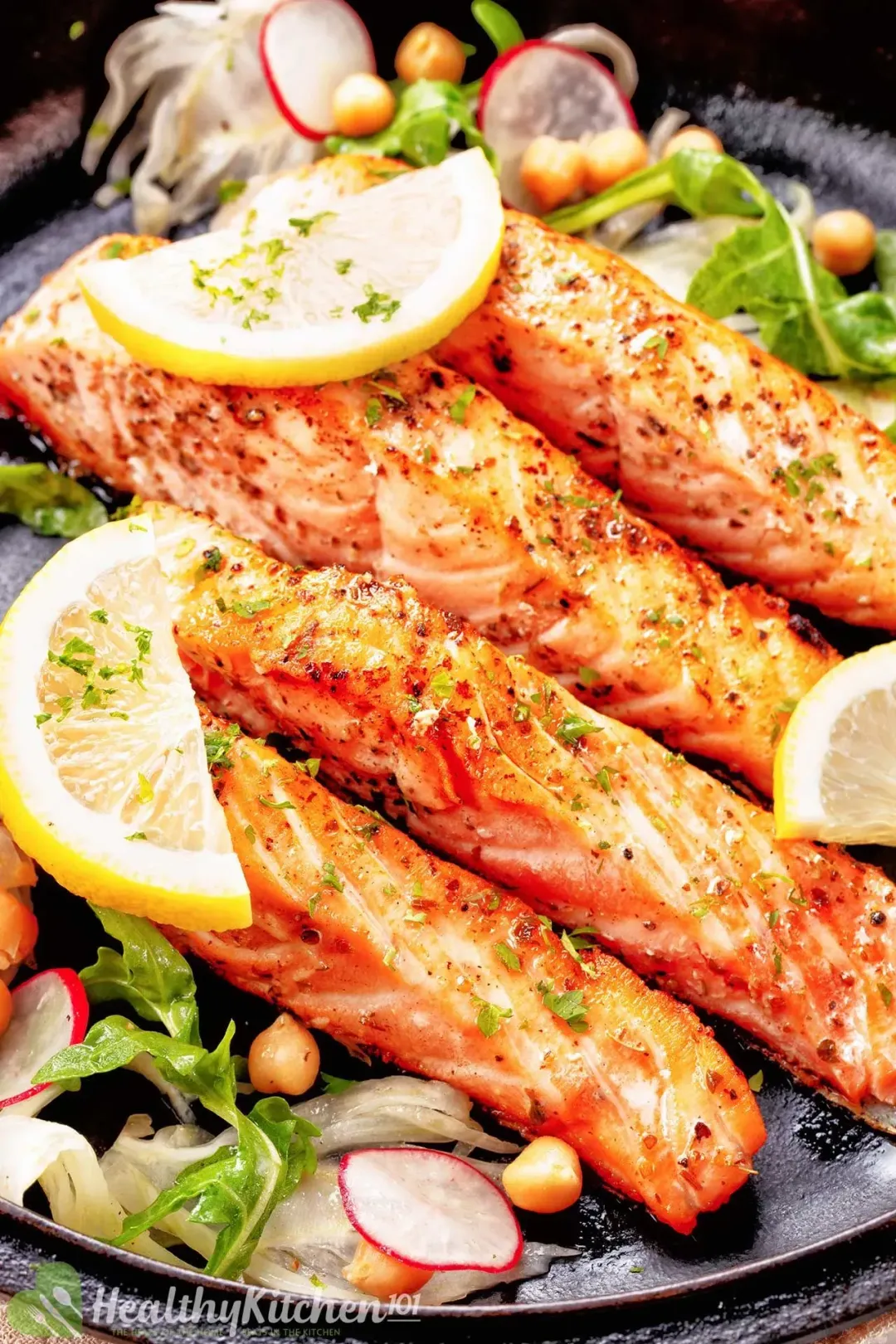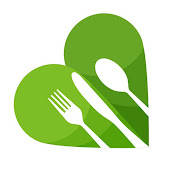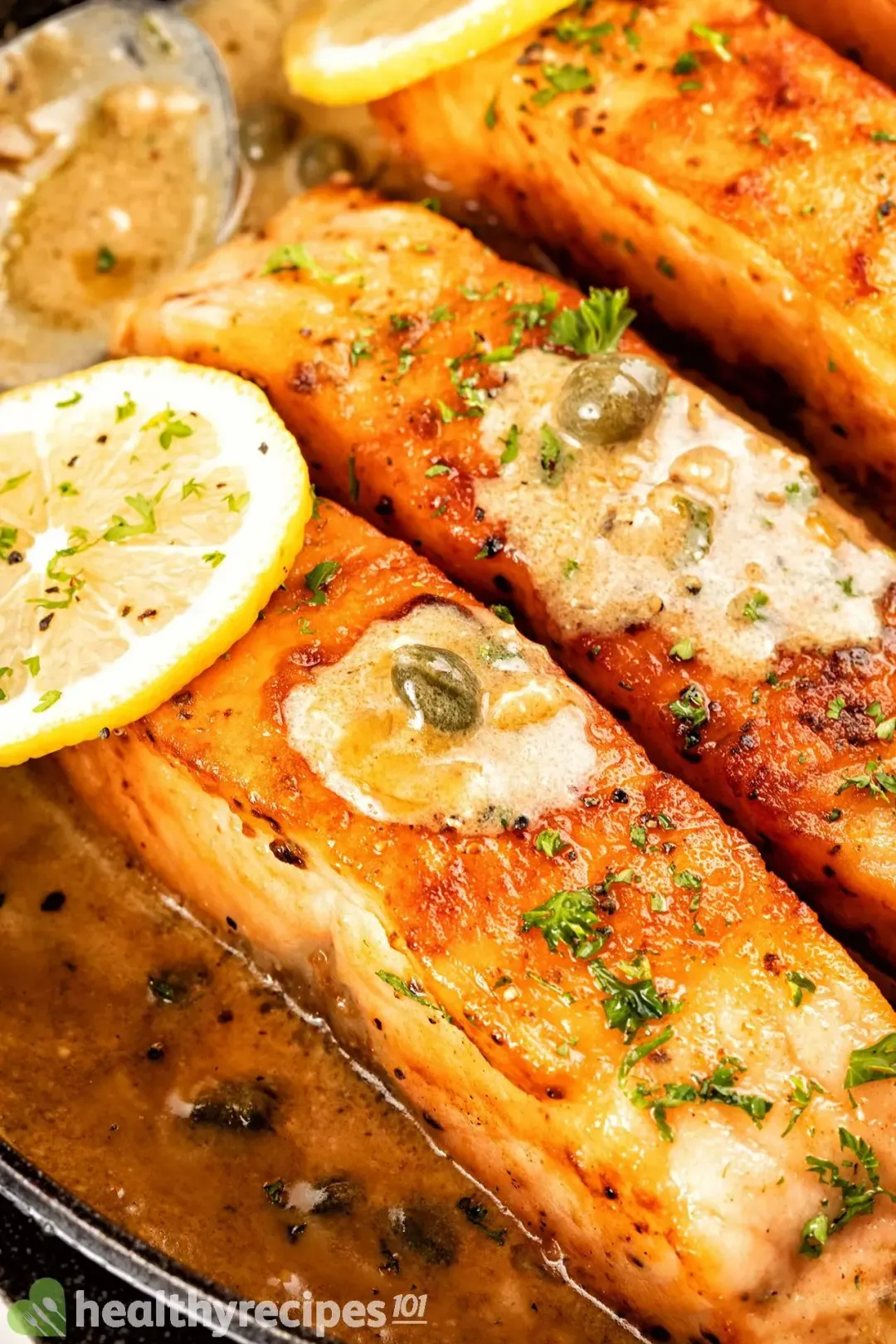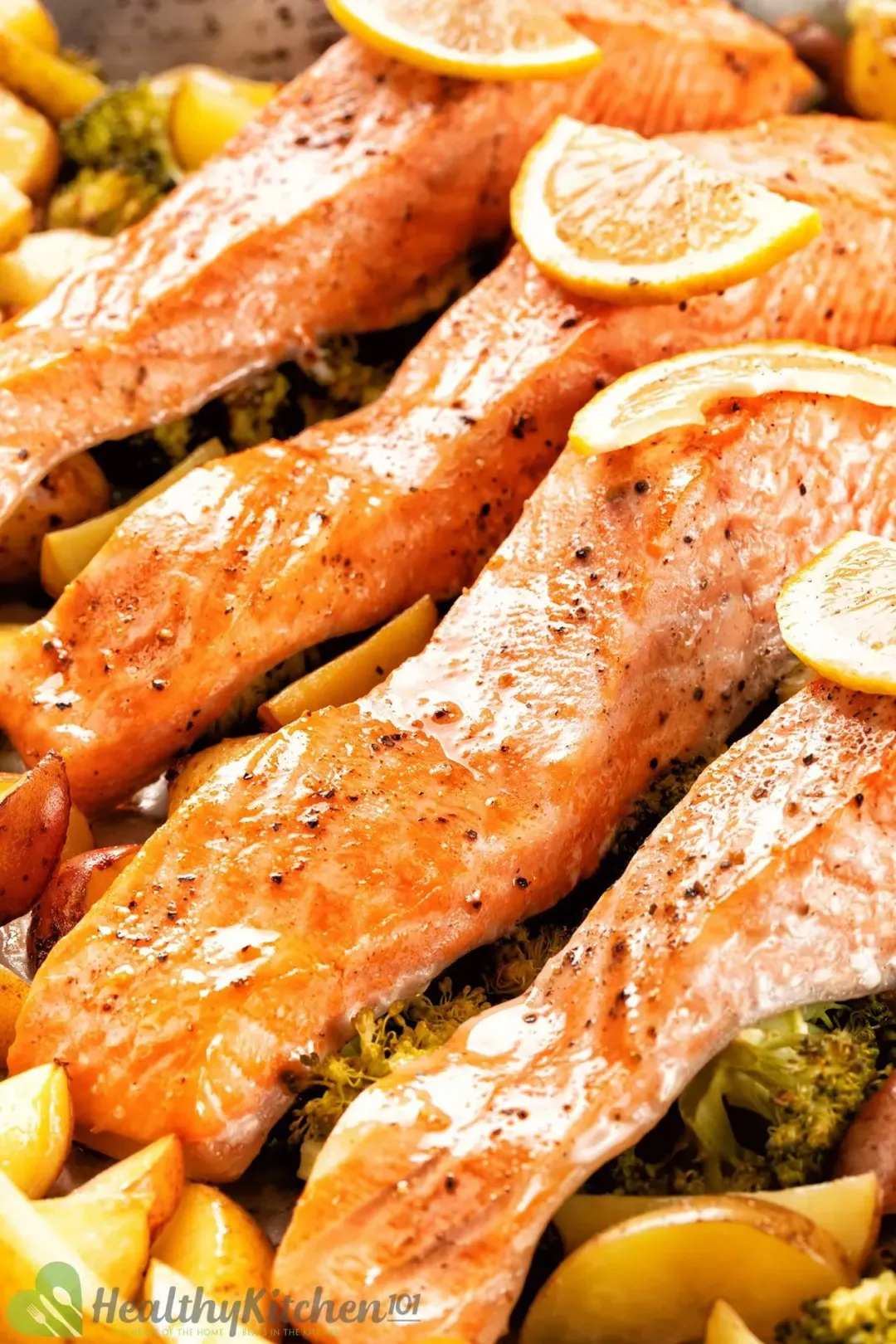Our pan fried salmon recipe can help you whip up a delicious, nutritious meal in under 15 minutes.
Do you crave a fine-dining experience but still want to feel full after? We can help you recreate the experience right at home, and guarantee a fulfilled belly and a satisfied palate.
In less than 15 minutes, you’ll have a tender, flaky salmon fillet with crispy skin, sitting on a bed of green bundles. It is a truly delectable experience.
If you’re in a hurry, click “jump to recipe” to go straight to the recipe card. Or, take your time and read on to learn about:
- How healthy salmon is
- What to season salmon with
- Tips for frying and serving salmon
- All about storing salmon
Is Pan Fried Salmon Healthy?
Yes, it is. Salmon is an all-round healthy food, and pan-frying is a cooking method that uses very little grease.
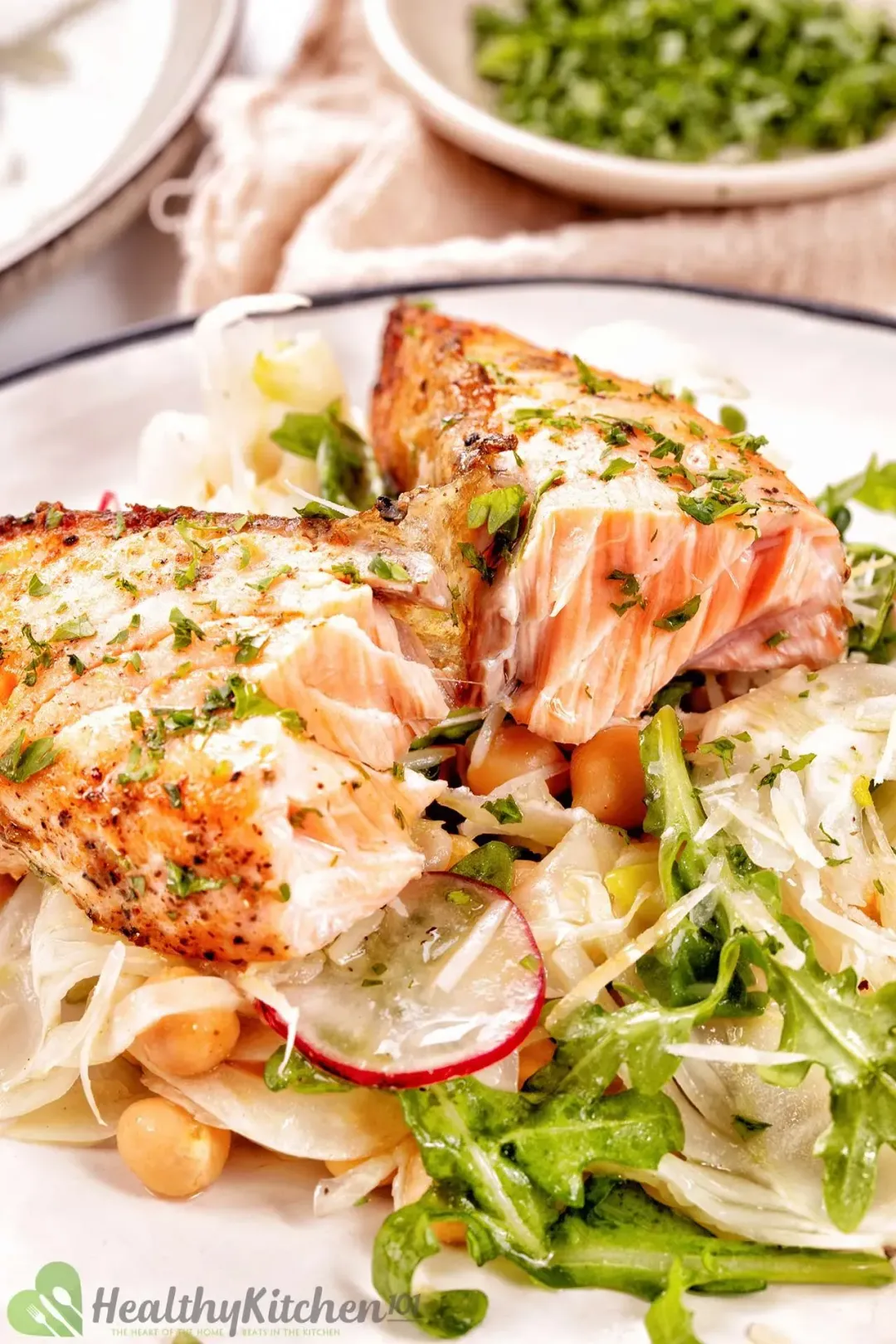
Different from other fish, salmon is one of the richest sources of omega 3. It’s scientifically proven to have positive health impacts, including lowering the risk of heart disease.
This health-promoting fish can be enjoyed in many different ways. Check out our other salmon recipes to help you include more salmon in your diet:
- Salmon Burger Recipe: a lower-cholesterol burger alternative that comes together in 30 minutes, tastes better and does the body good. The patties are juicy and the greens are extra fresh.
- Broiled Salmon Recipe: a hassle-free eat that takes 20 minutes, packs nutrients, and nurtures the soul. Who knew quinoa could taste so good?
- Blackened Salmon Tacos Recipe: an exotic taco for taco Tuesday. It takes only 35 minutes to make, is brilliantly balanced, and tastes better than a regular taco.
More later, the benefits of this dish don’t stop here. We’re also whipping up a quick accompaniment of arugula, fennel bulbs and chickpeas, all delicious ingredients packed with vitamins, minerals, and fiber.
How Many Calories?
As mentioned earlier, the “fried” part may give the impression of a greasy, unhealthy dish, but it’s not. The fish alone requires little oil to fry, and only yields around 250 calories.
It is the salad that brings the meal’s total calories to more than 450. The added calories come from olive oil, a little bit of butter, dressing, chickpeas, and veggies.
Seasoning
The rule of thumb when it comes to seasoning delicate fish (like salmon) is not to overdo it. The herbs and spices shouldn’t be overwhelming, but complementary.
Regarding what herbs to use, it’s a matter of experience really. Thyme is typically used, but we found oregano to be a lighter alternative, allowing other fragrances to shine through.
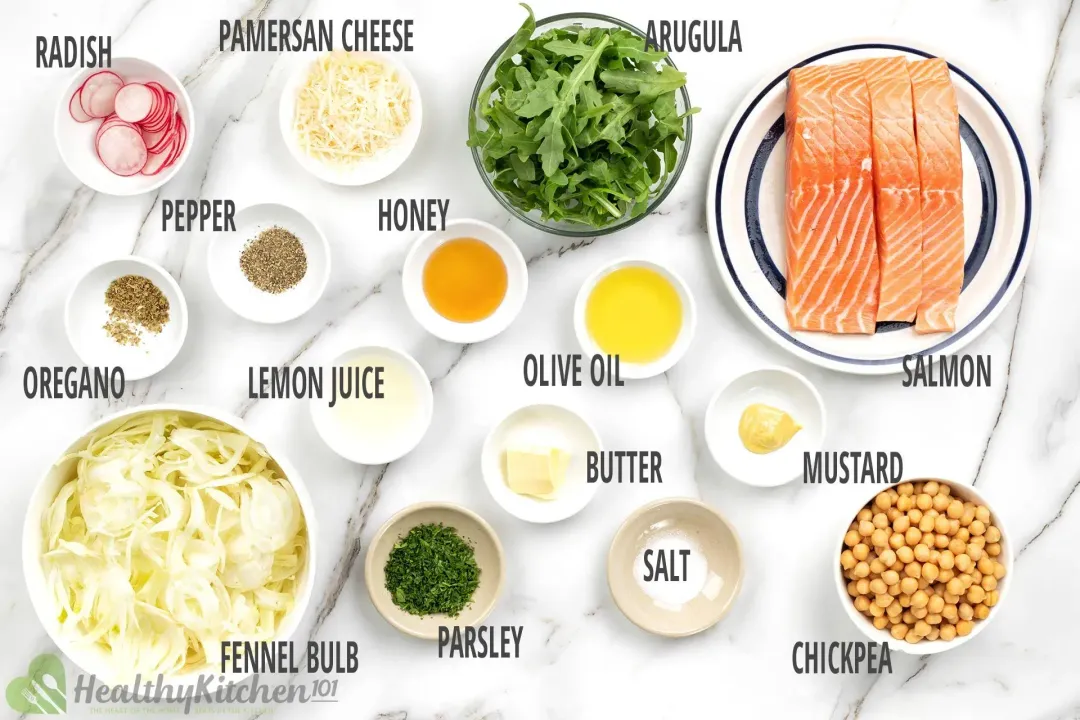
For that reason, our seasoning mix for this pan fried salmon recipe is just salt, pepper, and oregano. We keep it simple so the fish can pair with the aromatic salad of buttery chickpeas, fresh arugula, earthy fennel, and pungent dressing.
“It seems a lot, but a little bit of everything comes together nicely as a Michellin delicacy”— our team agreed. And indeed, it does.
Let’s move on by looking at some practical points.
How to Thaw Salmon Properly
If you forgot to thaw the fillets in the refrigerator, wrap them up and submerge them in cold water. Change the water every 10 minutes until the fillets are no longer frozen.
It’s important to keep the fillets cold and not at room temperature. This creates the perfect environment for bacteria to grow and ruin your food.
If you have a microwave, have it do the job for you. Be sure to set it to the lowest setting/thawing setting to avoid cooking the fish inside out.
How to Cook Frozen Salmon
If you don’t have time to wait, you can place the fish fillet in a baking dish, foil it, and bake in the oven. This brings its temperature up slowly, which allows it to cook evenly inside out.
There’s another cooking method called sous vide, where the food is wrapped, airtight-sealed, cooked in a warm, unchanging-temperature water bath. A special device keeps track of the water temperature, so your food is cooked evenly with just a tap of a button.
After cooking sous vide, you can take out your fish to sear it, which assures beautifully cooked salmon every time.
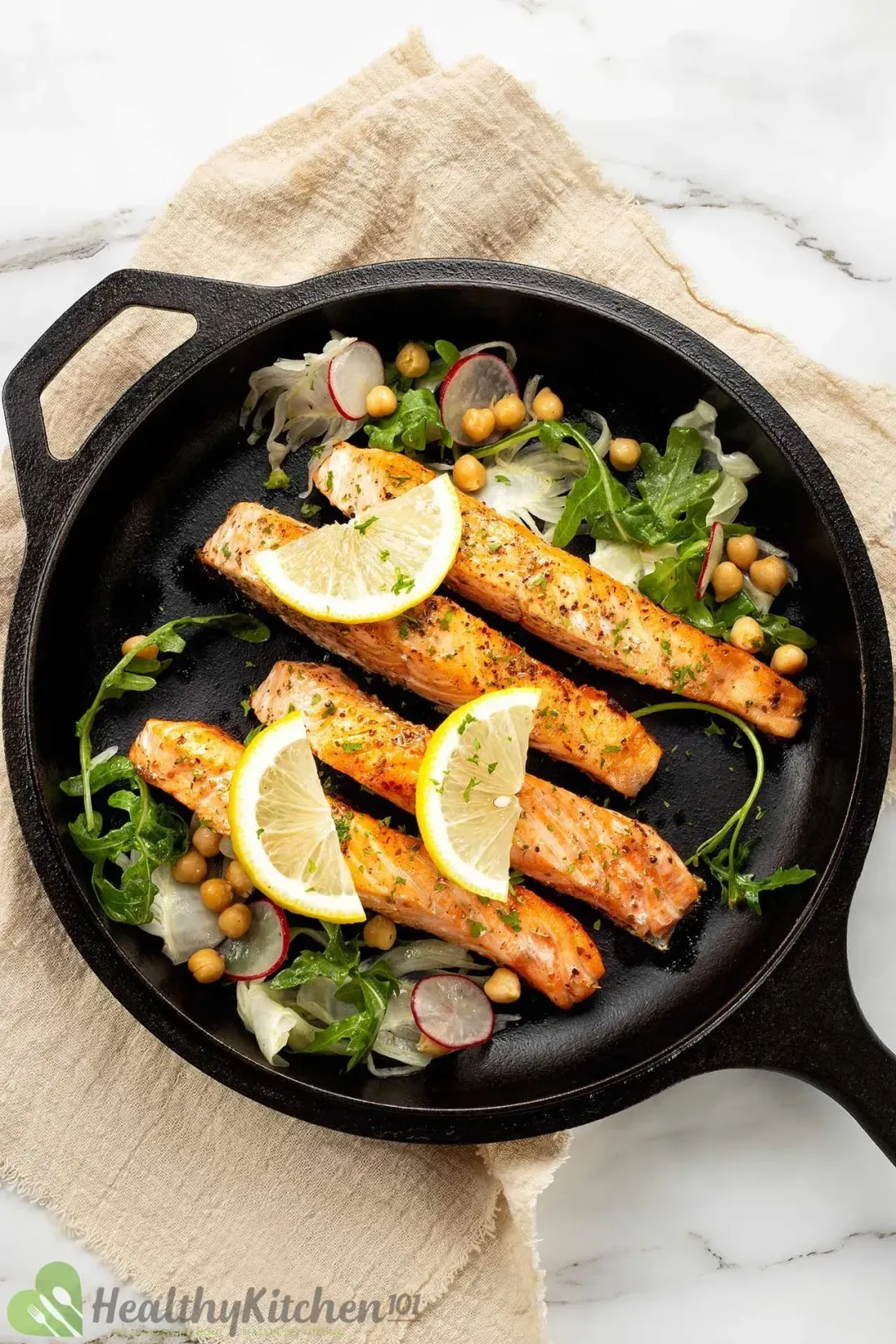
But again, if you don’t own a sous-vide cooking device, baking the fish in foil works just as well.
How to Get Crispy Skin Salmon
If a pan-fried salmon doesn’t come out with a golden, crisp salmon skin, it’s not done correctly. This pan fried salmon recipe will show you how to do it right, and it’s really easy.
Make sure the oil is heated over medium heat. When the oil gets all hot and shimmers, slowly place the fillet into the pan, skin-side down.
You’ll notice that the skin will shrink a little, and the salmon will turn from translucent to opaque from the bottom up. You’ll be tempted to flip it, but don’t; wait for 5 minutes and it should be cooked thoroughly without flipping.
To be sure the skin is crispy, run the tip of a knife over the skin, sort of lightly scraping it. You should hear a nice crisp sound; if not, give the skin some searing action until it’s crisp and golden.
When it’s time to plate up, you’ll want the salad to be ready so the fillet can be served right away. The skin loses crispness as it sits.
Can You Eat Salmon Skin?
Crisp salmon skin is not just edible, but also a tantalizing experience. It honestly didn’t occur to us why anyone wouldn’t until we came across this Healthline article.
It’s said that salmon skin (and salmon flesh) may contain contaminants depending on where the fish has been. PCBs, methylmercury for instance, are harmful to pregnant or nursing women.
In other words, pregnant or nursing women should be cautious when consuming salmon in general. Other than that, it is a delicious part of the fish and should be included whenever possible.
What to Serve with
The dish already has protein and greens, so it’s only natural to pair it with a side of carbs, like pasta. Here’s what we would recommend:
Among the many possible pasta sides, we found sweet potato gnocchi to be a great fit. It’s tender, flavorful and slightly chewy, adding not only flavors to the table but another texture as well.
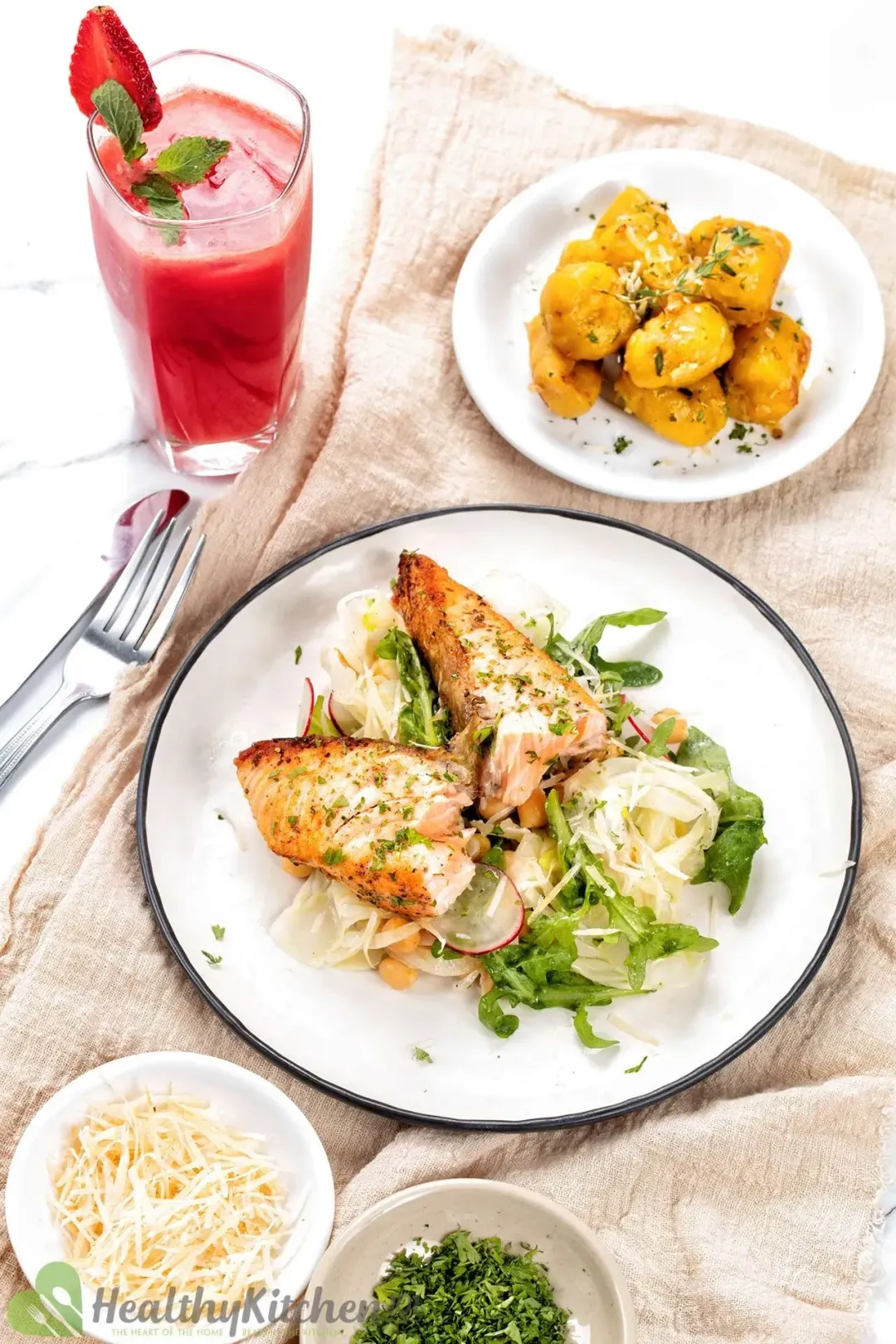
And to round off the meal, a refreshing juice that adds another layer of color/flavor is perfect. Our strawberry watermelon juice satisfies all of the criteria— an easy juice with a ruby hue that’s better than canned juices health- and taste-wise.
Storing FAQ
Eating freshly cooked food gives the best experience, but sometimes it’s not possible or practical to do so. We’ll show you the best way to store this pan fried salmon.
First of all, leaving your food out at room temperature is a big no-no. Bacteria in the air can cling on to the food and spoil it, and they multiply fast, especially in hot weather.
To optimize the lifespan of cooked salmon, you should store it in an air-tight container, and either freeze it or refrigerate it. The USDA states that cooked salmon can be stored up to 4-6 months in the freezer, and 3-4 days in the fridge.
To reheat the fillet, place it in the microwave or oven. If the fillet is frozen, it’s best to foil the fillet and bake it for around 30 minutes.
It’s also a good idea to cook your chickpeas beforehand and store them along with arugula, sliced fennels, and dressing in the fridge. You’ll save a lot of time doing so.
Pan Fried Salmon Recipe
Here is our pan fried salmon recipe unfolding in detail. You need nothing but a good heart to recreate this divine dish at home.
- cook TIME 7 mins
- prep TIME 8 mins
- total TIME 15 mins
- COURSE Main Course
- CUISINE Global
- SERVINGS servings
- CALORIES 452 kcal
INGREDIENTS
- 26 oz boneless salmon (cut into 4 fillets, thawed)
- 8 oz canned chickpeas
- 8 oz fennel bulb (sliced)
- 1 oz arugula (washed)
- 0.5 oz grated parmesan cheese
- 0.5 oz radish (sliced)
- 3 tbsp olive oil (divided into 2 and 1 (to make dressing and sear salmon))
- 1/2 tbsp honey
- 1/2 tsp salt (divided into 2 equal portions)
- 1/2 tsp pepper (divided into 2 equal portions)
- 1 tbsp unsalted butter
- 1 tbsp lemon juice
- 1/2 tsp traditional Dijon mustard
- 1/2 tsp dried oregano
- 2 tbsp parsley (chopped)
INSTRUCTIONS
Combine 1/4 tsp salt, 1/4 tsp black pepper, 2 tbsp olive oil, 1/2 tbsp honey, 1/2 tsp mustard, and 1 tbsp lemon juice in a bowl.
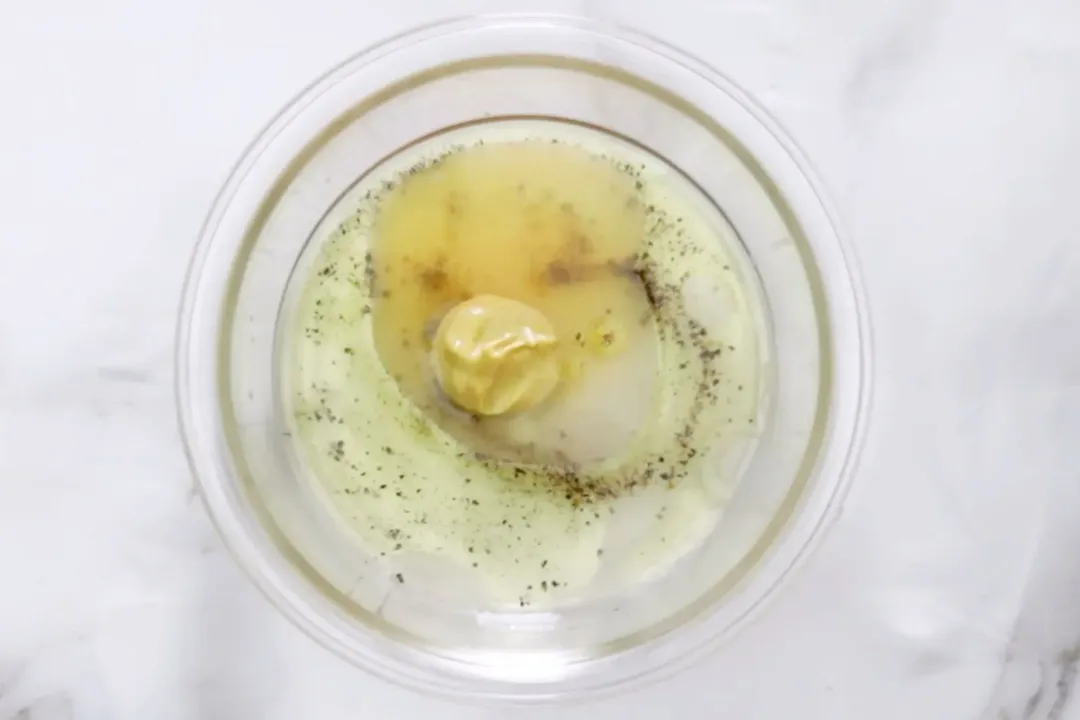
Season 26 oz boneless salmon with 1/4 tsp salt, 1/4 tsp black pepper, and 1/2 tsp oregano and let sit for 5 minutes.
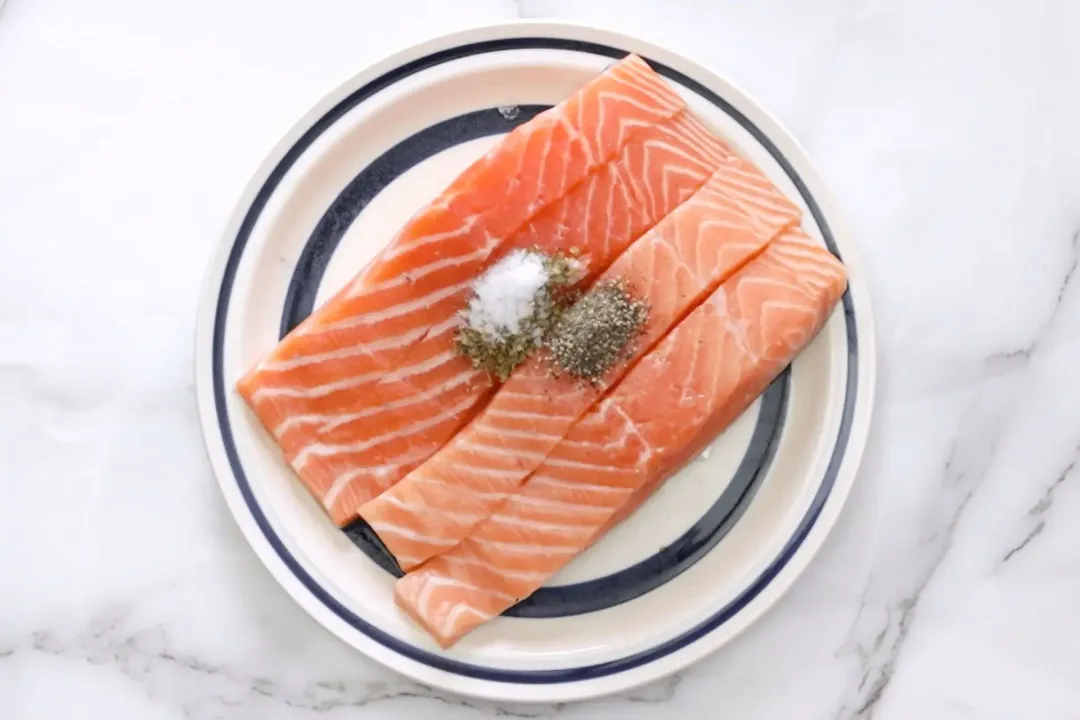
While it’s marinating, melt 1 tbsp butter in a pan over medium heat and stir in 8 oz chickpeas. Cook them for 2 minutes or until they’re tender and fragrant.
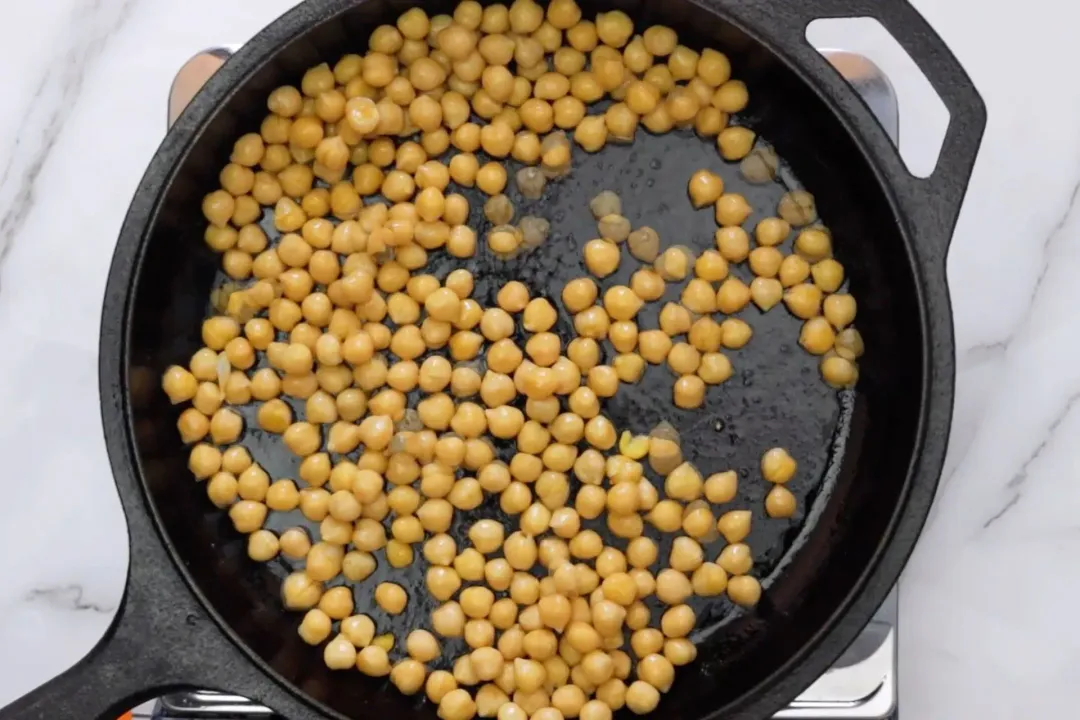
Place the chickpeas aside and in that same pan, heat 1 tbsp olive oil over low heat until it’s hot. Place the salmon skin side down and cook for 5 minutes or until the skin is crisp and golden brown. It helps to keep the slices close to each other so they don’t fall on their side. When it’s golden, turn off the heat and allow the residual heat to cook the fish thoroughly.
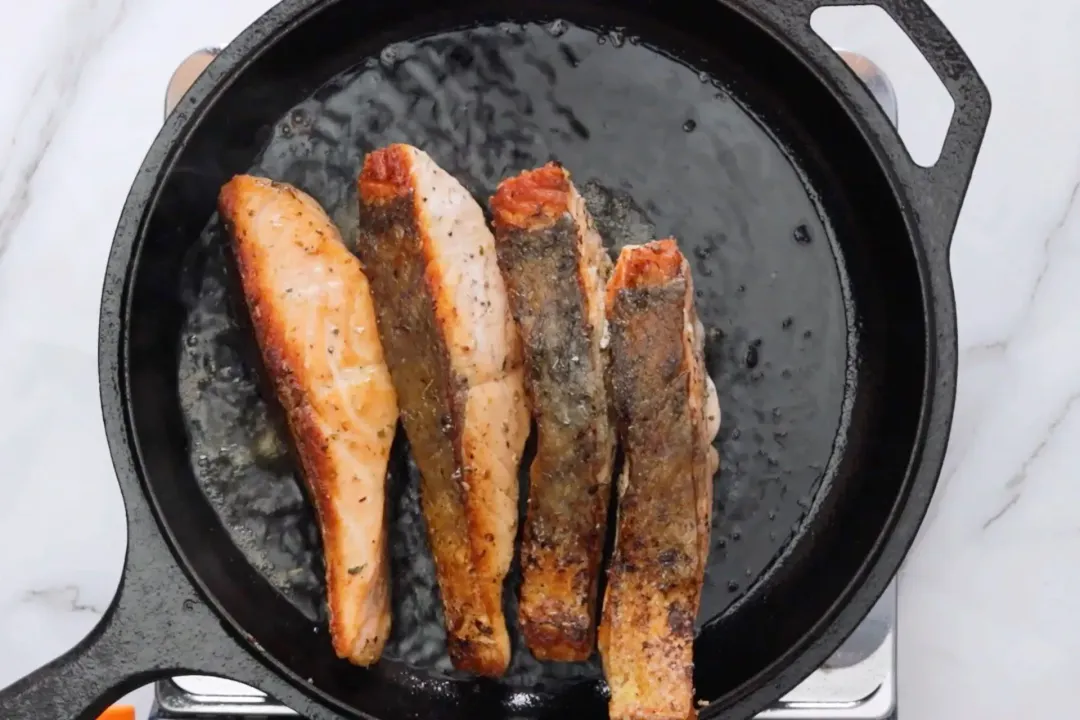
In a large bowl, toss 1 oz arugula, 0.5 oz radish, 8 oz fennel, and chickpeas with the prepared dressing.
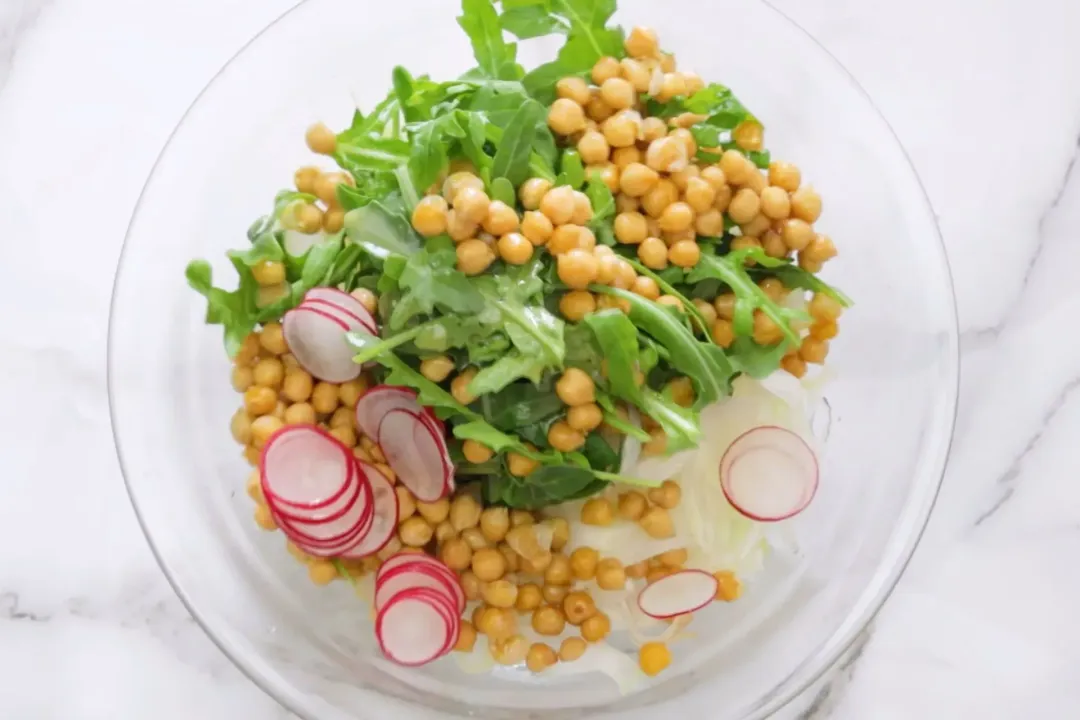
Plate by placing a measured amount of salad in the middle of a serving dish. Grate 0.5 oz parmesan on top of the salad. Place one salmon fillet on top and garnish with parsley. Serve hot and enjoy.
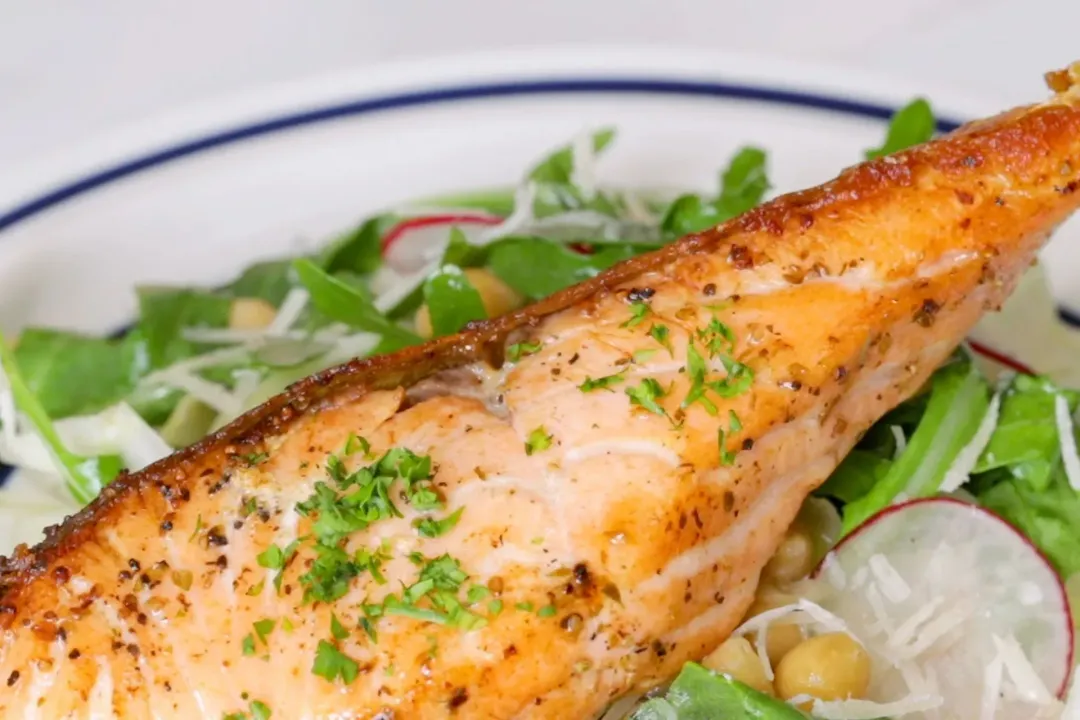
NUTRITION
Tuyet Pham
Head Chef, Culinary ConsultantLuna Regina
Writer, AuthorLizzie Streit, MS, RDN, LD
Nutrition Reviewer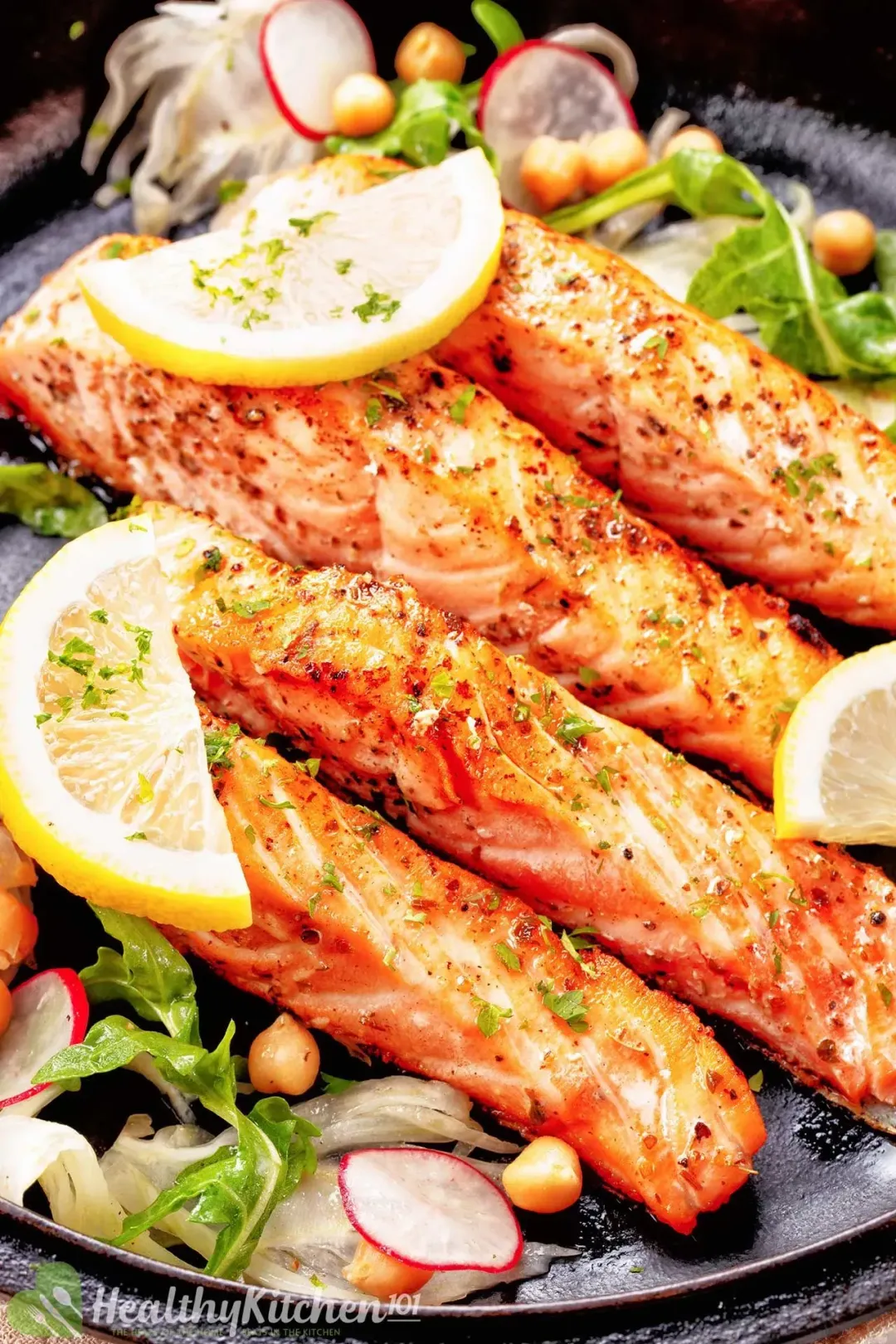
- CynthiaSimple yet flavorful and a great option for a quick and healthy dinner.
